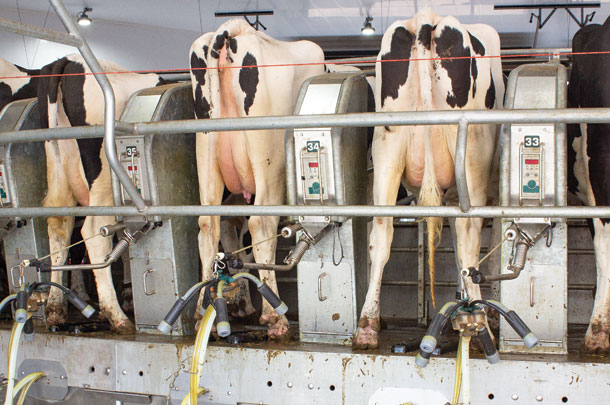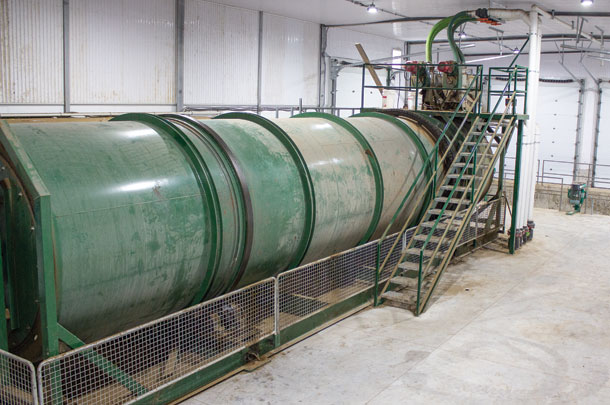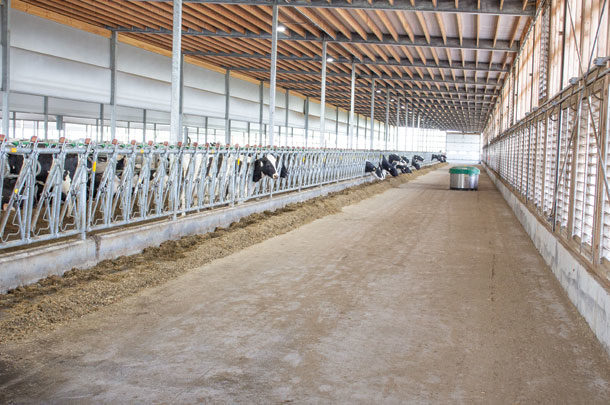The dairy in Woodham, Ontario, is owned by Gerben and Ria Steenbeek and their children, Gerard and Tanya Steenbeek, Nanda and Lennert Vervoort, and Jordan and Sarah Steenbeek.
Jordan manages the herd at the original farm site, while Lennert oversees the cows at the second farm. Gerard maintains equipment and takes care of fieldwork for both operations, and his wife, Tanya, is the bookkeeper.
They have 16 employees including some from the foreign temporary worker program.
The original farm saw its first freestall barn built in 1997. A second freestall barn was constructed in 2006, and it was extended six years later.
The second farm was purchased in 2011. They maintained two separate quota holdings but shared cattle between the farms.
In addition, they kept purchasing as much quota as they could. By 2016, they were up to 600 cows milking 3X in a double-12.
“There were not enough hours in a day,” Gerard said during a tour hosted by the Progressive Dairy Operators (PDO) in September.
“We always wanted to build a rotary parlour,” he added, but due to minimum distance requirements they could not build a parlour by the existing buildings.
In fall 2018, they started construction of a new wide-body, cross-ventilated barn with a 50-stall rotary parlour on the original farm. The barn is 12-row head-to-head with 900 deep-bedded stalls. It is home to about 600 cows, with another 300 cows milked at the other farm.

With the rotary, they can milk 240 cows per hour and are done in about 2.5 hours each milking. Cows are milked 3X, and they average 38 to 39 litres per cow with a 180,000 somatic cell count (SCC).
There are three employees per milking with one to prep, one to attach and one to fetch cows.
They use a teat scrubber with a disinfectant solution to consistently prep the cows. Good stimulation has helped cows reach an average milkout in four minutes.
A camera system is set up to allow the person in the prep position to see the far side of the parlour and control the crowd gate better. There are two lanes to guide cows to and from the parlour more efficiently.
Cows are sorted off the parlour using computerized records and activity monitors. In the morning, they focus on herd health and reproduction. Hoof trimming is done in the afternoon, and group changes occur at night.
They have four different sort pens and go through a bale of hay a month for this area. Once cows are done, they can be released while the other pens remain occupied. This area is flushed with recycled water from the holding area.
The main barn is tractor-scraped during milking and transferred to a receiving pit.

The manure is separated to 35% dry matter with a screw press separator. The solids spend two days in an in-vessel composting system, which holds a temperature of 150ºF.
“That’s a good temperature to kill bacteria but not break down the fibres,” Jordan said.
The unit creates enough heat to keep the building it is in from freezing. They spend 30 to 60 minutes per week on composter maintenance and clean the separator screens every couple of weeks.
The compost is used for bedding. The milking cows supply enough solids to also bed the heifers and calves older than 4 months. These animals are housed in the existing barns on the farm, where they installed a curb to convert the stalls for deep bedding.
“Manure solids don’t wear out pumps,” Jordan said. “We find if we overfill stalls and then pull some out with the leveler, it is better to waste some than to be underfilled.”
Stalls are bedded on Mondays, Wednesdays and Fridays and leveled every afternoon.
Not only did the cross-vent barn best accomplish their goal of more cows on a smaller footprint, but it provides good airflow for cow comfort.
There are curtain baffles to guide airflow to cow level and ridge fans to help with winter ventilation.
Curtains are raised in winter and dropped in spring. When all fans are running, the air is exchanged every minute, and they’ve witnessed less heat stress.
“The cows lay down. There is a lot less heavy breathing,” Jordan said. “When there is no wind outside, that’s when this barn shines.”
The barn is designed with tractor traffic lanes at the end of the pens. This keeps feed lane connections under roof. By minimizing doors opening and closing, there is less disruption of air flowing across the barn.
Cows receive fresh TMR in the morning. Two automated feed pushers run in two- to three-hour intervals and cover the three feed alleys.
Headlocks line the feed rail, which Jordan said aids feed efficiency by 3%.
The old parlour serves as a hospital parlour. Milk is pasteurized before being fed to calves. That has reduced mortality and health issues.
Calves are housed in hutches and fed 3 litres by bottle 3X. The old nipples are used for young calves and new nipples to older calves.
They start weaning at 45 days old by removing the night feeding. Every week another feeding is removed, and calves are moved from the hutches at 10 weeks old.
While the new construction was done to accommodate growth, Jordan said it also enabled bigger steps towards improving farm operations by reducing milking time, recycling bedding and increasing cow comfort. ![]()
PHOTO 1: A 12-row, wide-body, cross-ventilated barn helped the farm put more cows on a smaller footprint.
PHOTO 2: The new 50-stall rotary parlour and teat scrubber for cow prep has sped up milking time considerably at Stonecreek Farms.
PHOTO 3: An in-vessel system composts separated manure solids, which is reused on the farm for bedding. Photos by Karen Lee.

-
Karen Lee
- Editor
- Progressive Dairy
- Email Karen Lee









